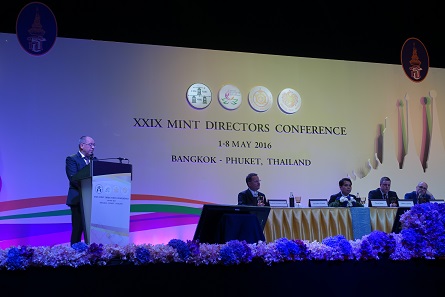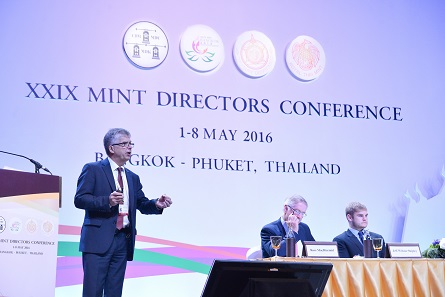by Ursula Kampmann
translated by Annika Backe
June 2, 2016 – From May 1 to 4, 2016, the Mint Directors Conference took place in Bangkok. It was attended by nearly 360 delegates for whom 35 presentations were held. Here you find the first part of a short abstract of the papers given. The focus is placed on the plenary sessions.
In the inaugural speech, Günther Waadt represented Dr Rüdiger Voss of the European Commission. Photograph: UK.
Future Payment Systems
The first session dealt with future payment systems and was chaired by Dr Manfred Matzinger-Leopold.
Dr Rüdiger Voss / European Commission, Recent Developments in the Euro Coinage
Responsible for the first presentation was Dr Rüdiger Voss of the European Commission who, unfortunately, had to cancel at the last second. Günther Waadt stepped into the breach who submitted himself to the challenging task of interpreting the findings of the non-attending speaker for the audience by a PowerPoint presentation.
For starters, the speaker pointed to the problem of creating a joint currency for different nations of differing levels of economic development.
While in Luxembourg the average day net pay for an employee is 104 euros, in Latvia it is only 17.80 euros. The smallest denomination should thus have an equal value of 2.8 cents in Luxembourg and 0.36 cents in Latvia, and the coin/note boundary should amount to 5.20 euros for Luxembourg and 0.89 euros for Latvia.
Furthermore, the speaker emphasized the high production costs and high increase in demand regarding the three lower denominations, before addressing the issue of the future of both the 1 and the 2 cent piece. The great majority of citizens would approve of the abolition of these two denominations. Some members of the monetary union have already taken this step. Although it would be possible to arrive at a more cost-efficient production of the mentioned denominations, there is also the legal obligation of the Commission to review the appropriateness of the coinage system at regular intervals.
When it comes to the protection against counterfeiting, quite satisfying results have been obtained. The number of counterfeit coins has slightly increased. Although a total of 192,195 coins were seized in 2014, this is of little importance in the light that about 17 billion coins are currently in circulation.
In terms of the quantity of euro coins, the stock of already produced 1 euro coins is large enough to render the production of any further specimens unnecessary for the next 12 years, given demand remains steady. As for the smallest denominations, the stock in years of net issue is only about half a year.
The future of cash payment was a topic on which Rüdiger Voss refused to make any clear-cut statements. He said that every single study arrived at the conclusion intended by the one who commissioned it. The European Commission would abstain from taking sides to support any payment system.
Dr Pairoj Balun / Bank of Thailand, The Cost and Future of Payments
Contrary to many European countries, in Thailand cash is still king. However, the number of cashless payments increases more rapidly than ever in Thailand as well.
Because of that, Dr Pairoj Balun investigated the total costs of payment – for the individual as for society as a whole – and the increasing importance of electronic payments. For his study, he chose seven countries: Sweden, the Netherlands, the UK, the US, Korea, Malaysia, and Thailand.
He was able to prove that, in all countries examined, the costs for the credit card is steadily decreasing, resulting in a rise of the number of electronic transactions.
In Thailand and Malaysia, on the other hand, where cash is still much cheaper than alternative payment systems, credit cards and debit cards do not feature prominently in the day-to-day economic life.
Dr Pairoj Balun concluded by laying out the national e-Payment master plan as a means of the Thai government aimed at further promoting e-Payment services. Every Thai citizen is planned to receive an ID with which he or she can make electronic payments. The long term goal is the replacement of cheques and cash by cashless transactions.
Miika Syrjänen / Bank of Finland, Finnish Cash Cycle and Future Trends
In his presentation, Miika Syrjänen of the Bank of Finland described the decline of cash transactions in his country. It was decided to not issue 1 and 2 cent coins anymore but to replace these by symmetric rounding of the total sum of a purchase to 5 cents. While the net issue of coins between 5 cents and 1 euro remained more or less constant, only the number of issued 2 euro coins has increased.
The number of bank branches offering their customers the service of getting cash being on the decline may be a contributing factor to the number of electronic payments rising.
Miika Syrjänen concluded his paper with the provocative statement that, once digital payments had all the same benefits as cash (immediate settlement of a debt / costs / anonymity) –, cash in its current format would become obsolete.
Simon Lake / Royal Mint, The Coin/Banknote Boundary – A Challenge to our Industry
The enthusiastic appeal to unite for propagating a rising of the coin/note boundary with the central banks was made to the audience by Simon Lake. Of high rhetorical merit, his contribution was thought-provoking for many attendees: As a matter of fact, central banks would favor banknotes although there was a seven point argument for coins. In terms of its lifetime cost, a coin would be much less expensive than any banknote and generated a higher seigniorage for the national bank. Coins were more environmentally friendly and easier to recycle.
Nevertheless, more and more countries abolished the smallest denominations without raising the coin/note boundary at the same time. Simon Lake said that it was to be expected that in the near future, the annual amount of coins to be manufactured would most likely drop from 60 billion to only 35 billion. He went on to say that, to inform the central banks for the coining industry’s best interest, a joint approach was called for. It would be the task of the complete sector to develop a convincing line of argument.
Ross MacDiarmid, Royal Australian Mint’s CEO, not only chaired the final session of the MDC but also held a presentation himself. Photograph: Mint of Thailand.
Corporate Culture
Corporate Culture was the title of the final MDC session which again addressed all attendees.
Ross MacDiarmid, CEO of the Royal Australian Mint, acted as session chair. The first speaker he introduced was a colleague of his.
Jeff Wilson-Shipley reported on the experiences he made at the British Royal Mint, as the winner of the Janine Murphy Scholarship. Photograph: Mint of Thailand.
26 year-old Jeff Wilson-Shipley made good use of the Janine Murphy Scholarship to gain experience in an exchange with the British Royal Mint. Enthusiastically, he reported on his experiences and the insights he gained.
Dr Peter Huber, Director of the State Mints of Baden-Wuerttemberg and Chairman of the Benchmarking Committee. Photograph: Mint of Thailand.
Dr Peter Huber / State Mints of Baden-Wuerttemberg, Benchmarking in the Minting Industry
In his capacity as Chairman of the Benchmarking Committee, Dr Peter Huber presented the findings of the previous two years. He emphasized the importance of developing performance benchmarks for the industry. He said that far too few mints participated in the area of Key Performance Indicators – in 2015, the number amounted to a mere 8. In comparison: In the 2016 Mint Directors Conference representatives of 35 mints were participating. Whatever the reasons may be only the active participants are granted access to the detailed interpretation of the data analysis. To all others, the presentation only outlined the scope of the participating mints:
With a range of 30 to 300 full-time equivalents, they produce about 50 to 600 coin designs, using 1,000 to 20,000 dies. By the way, in most mints the majority of employees are still working in the Production. Sales and Marketing only make for 3 to 10% in 60% of mints.
For the technical division, 18 mints participated, more than twice the number of participants in the category Key Performance Indicators. In an exemplary manner, the underlying reasons were presented by Dr Peter Huber who took the assembled data to thoroughly assess which press force, in combination with which relief height and which blank thickness lead to the longest life of the chrome plated dies.
There is also an external view on mints. Upon request, representatives of the supplying industry carry out evaluations, on which Peter Huber expanded. Remarkable was the fact that, when compared to 2014, safety has increased whereas cleanliness in general within the mints has decreased. Exact the same holds true for the blank producers investigated. The lowest value was obtained in Cooperation and Knowledge Sharing.
As an outlook, Peter Huber announced that a book on benchmarking was planned for 2017 with key trend analyses.
Leighton John / The Royal Mint, World Class Manufacturing @ The Royal Mint
In his paper, Leighton John referred to the challenges ahead, cash payment being more and more rivalled by other payment systems. He pointed out that there was still time. However, advantage must be taken of that time to ensure improvement. The goal would be to reduce transport, motion of goods and idle time, over processing, over production, waste of human potential, and defects. The Royal Mint, he stressed, worked systematically towards optimization which, as a rewarding result, led to constantly rising profits.
Ross MacDiarmid / Royal Australian Mint, Leading Minties – a Leadership Program
Ross MacDiarmid introduced a program that is run by the Royal Australian Mint with great success since 2010. The goal is to install the motivation for change among the markedly conservative staff. To that end, seminars were conducted that aimed to make the mint’s staff become ‘agents of change’. As informal leaders, these are the right persons to promote and facilitate change.
The ‘Leading Minties’ program took 11 months and was implemented in the on-site working process. The focus was placed on the individual development of the participants and their capability to take the lead. By means of teaching units, simulations, discussion groups and continuous feedback, the participants were guided through the program. During the first five months, they learned from theory to better evaluate and use their own skills. During the next six months, a mentor supervised every participant’s learning journey. Teamwork and courses on motivation and stress management supplemented the training. The result is impressive. To date, one in four employees underwent the program. There have been 17 internal promotions. Six leaders have successfully departed to higher positions in other companies. And, as a side effect, the staff’s interest in external training has increased significantly as well.
In the upcoming part of the abstract of the papers given at the MDC we will focus on the presentations of the Technical Committee.
Please find a general contribution on the Mint Directors Conference here.
And the website of the 2016 MDC in Bangkok can be found here.







